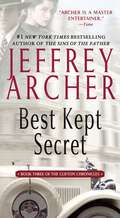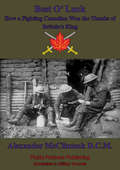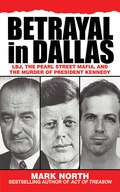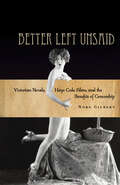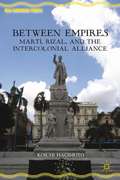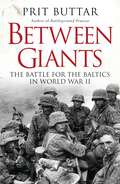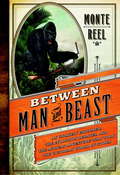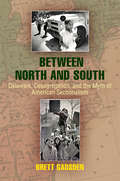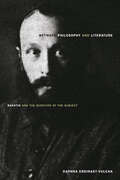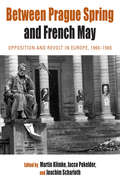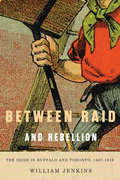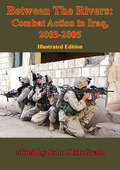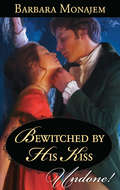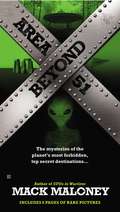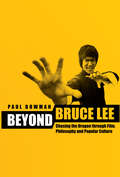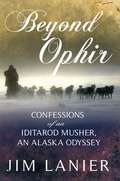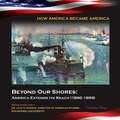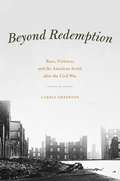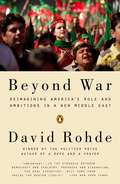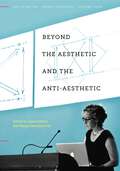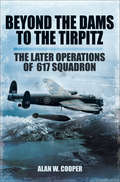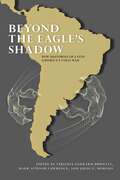- Table View
- List View
Best Kept Secret (The Clifton Chronicles #3)
by Jeffrey ArcherJeffrey Archer's mesmerizing saga of the Clifton and Barrington families continues...1945, London. The vote in the House of Lords as to who should inherit the Barrington family fortune has ended in a tie. The Lord Chancellor's deciding vote will cast a long shadow on the lives of Harry Clifton and Giles Barrington. Harry returns to America to promote his latest novel, while his beloved Emma goes in search of the little girl who was found abandoned in her father's office on the night he was killed. When the general election is called, Giles Barrington has to defend his seat in the House of Commons and is horrified to discover who the Conservatives select to stand against him. But it is Sebastian Clifton, Harry and Emma's son, who ultimately influences his uncle's fate.In 1957, Sebastian wins a scholarship to Cambridge, and a new generation of the Clifton family marches onto the page. But after Sebastian is expelled from school, he unwittingly becomes caught up in an international art fraud involving a Rodin statue that is worth far more than the sum it raises at auction. Does he become a millionaire? Does he go to Cambridge? Is his life in danger? Best Kept Secret, the third volume in Jeffrey Archer's bestselling series, will answer all these questions but, once again, pose so many more.
Best O'Luck: How A Fighting Canadian Won The Thanks Of Britain's King
by Alexander McclintockAn American with the British forces in France during the First World War recounts his experiences and how his exploits won him the Distinguished Conduct Medal.Alexander McClintock did not have any literary pretensions when he started out to write his autobiography, knowing that there were others would might write of the frontline better; however he was certain that they "sort of missed the essentials and lacked the spirit of the "ditches"". The Author in his own broad American style recalls how he decided to join the Canadian Army on the basis of the mistreatment of Belgium by the invading German hordes, a decision he took purely by chance after a meeting with some Canadians in the Knickerbocker Bar in New York! He enlisted and found himself in the famous Canadian Grenadier Guards, and after an uncomfortable journey cramped aboard the steamer the Empress of India, arrived in France.Things were rough and ready in France with his training far shorter than pre-war leading his training sergeant to exclaim that "when I see you handle your rifles I feel like falling on my knees and thanking God that we've got a navy". However ill-trained in theory nothing could prepare them for the brutality of the trenches; the author recounts the shot, shell and gas that he and his comrades suffered under before he was wounded and invalided to England. There in hospital he was visited by the King himself and awarded the D.C.M. for his part in the attacks on the German trenches on the Somme.
Betrayal in Dallas: LBJ, the Pearl Street Mafia, and the Murder of President Kennedy
by Mark NorthJohn F. Kennedy was assassinated in Dallas by Mafia contract killers hired by Louisiana mob boss Carlos Marcello. Longtime local district attorney Henry Wade, an LBJ crony who would have sole jurisdiction over the prosecution of those responsible, had been corrupted by the local Civello crime family. Lyndon B. Johnson, while a US senator during the 1950s, had accepted bribes from the same mobsters so that they could avoid deportation.With incredible detail and documentation, Mark North pieces the puzzle together to reveal how, in late 1961, US Attorney General Robert Kennedy and his brother John, who hated LBJ, initiated a covert Organized Crime Task Force investigation of the Civello mob in Dallas. Johnson, through Wade and local federal officials he had placed in power, learned of the plan and cooperated with the Civello mob to have JFK killed. Johnson did this, in part, because he had the power to control any subsequent federal investigation via FBI director J. Edgar Hoover. After the Mafia killed JFK, Johnson stopped Robert Kennedy's prosecution of the Dallas Mafia.Betrayal in Dallas is unlike any book written on the JFK assassination. Because its conclusions are based on classified federal documents unknown to the public and research community, it will startle and convince all those who read it. Betrayal in Dallas is what the American people have been waiting for since November 22, 1963.
Better Left Unsaid: Victorian Novels, Hays Code Films, and the Benefits of Censorship
by Nora GilbertBetter Left Unsaidis in the unseemly position of defending censorship from the central allegations that are traditionally leveled against it. Taking two genres generally presumed to have been stymied by the censor's knife--the Victorian novel and classical Hollywood film--this book reveals the varied ways in which censorship, for all its blustery self-righteousness, can actually be good for sex, politics, feminism, and art. As much as Victorianism is equated with such cultural impulses as repression and prudery, few scholars have explored the Victorian novel as a "censored" commodity--thanks, in large part, to the indirectness and intangibility of England's literary censorship process. This indirection stands in sharp contrast to the explicit, detailed formality of Hollywood's infamous Production Code of 1930. In comparing these two versions of censorship, Nora Gilbert explores the paradoxical effects of prohibitive practices. Rather than being ruined by censorship, Victorian novels and Hays Code films were stirred and stimulated by the very forces meant to restrain them.
Between Court and Confessional
by Kimberly LynnBetween Court and Confessional explores the lives of Spanish inquisitors, closely examining the careers and writings of five sixteenth- and seventeenth-century inquisitors. Kimberly Lynn considers what shaped particular inquisitors, what kinds of official experience each accumulated, and to what ends each directed his acquired knowledge and experience. The case studies examine the complex interplay of careerism and ideological commitments evident in inquisitorial activities. Whereas many studies of the Spanish Inquisition tend to depict inquisitors as faceless and interchangeable, Lynn probes the lives of individual inquisitors to show how inquisitors' operations in their social, political, religious, and intellectual worlds set the Inquisition in motion. By focusing on specific individuals, this study explains how the theory and regulations of the Inquisition were rooted in local conditions, particular disputes, and individual experiences.
Between Empires
by Koichi HagimotoIn 1898, both Cuba and the Philippines achieved their independence from Spain and then immediately became targets of US expansionism. This book presents a comparative analysis of late-nineteenth-century literature and history in Cuba and the Philippines, focusing on the writings of Jos#65533; Mart#65533; and Jos#65533; Rizal to reveal shared anti-imperial struggles.
Between Giants: The Battle for the Baltics in World War II
by Prit ButtarWith the exception of Poland, no region or territory suffered more greatly during World War II than the Baltic States. Caught between the giants of the Soviet Union and the Third Reich, Latvia, Lithuania, and Estonia became pawns in the desperate battle for control of Eastern Europe throughout the course of World War II. This is a story of conquest and exploitation, of death and deportation and the fight for survival both by countries and individuals. The three states were repeatedly occupied -- by the Soviet Union in 1939, by Germany in 1941, and again by the Soviet Union in 1944-45. In each case, local government organizations and individuals were forced to choose between supporting the occupying forces or forming partisan units. Many would be caught up in the bitter fighting in the region and, in particular, in the huge battles for the Courland bridgehead during Operation Bagration when hundreds of thousands of soldiers would fight and die in the last year of the war. Over 300,000 Soviet troops would be lost during the repeated assaults on the 'Courland Cauldron' before 146,000 German and Latvia troops were finally forced to surrender. No mercy was shown and all Latvians, Lithuanians, and Estonians who fought for Germany were executed. By the end of the war, death and deportation had cost the Baltic States over 20 percent of their total population and the iron curtain would descend on the region for over four decades. Using numerous first-hand accounts and detailed archival research, Prit Buttar weaves a magisterial account of the bitter fighting on the Eastern Front and the three small states whose fates were determined by the fortunes and misfortunes of war.
Between Man and Beast
by Monte ReelThe unbelievably riveting adventure of an unlikely young explorer who emerged from the jungles of Africa with evidence of a mysterious, still mythical beast--the gorilla--only to stumble straight into the center of the biggest debate of the day: Darwin's theory of evolution In 1856 Paul Du Chaillu marched into the equatorial wilderness of West Africa determined to bag an animal that, according to legend, was nothing short of a monster. When he emerged three years later, the summation of his efforts only hinted at what he'd experienced in one of the most dangerous regions on earth. Armed with an astonishing collection of zoological specimens, Du Chaillu leapt from the physical challenges of the jungle straight into the center of the biggest issues of the time--the evolution debate, racial discourse, the growth of Christian fundamentalism--and helped push each to unprecedented intensities. He experienced instant celebrity, but with that fame came whispers--about his past, his credibility, and his very identity--which would haunt the young man. Grand in scope, immediate in detail, and propulsively readable, Between Man and Beast brilliantly combines Du Chaillu's personal journey with the epic tale of a world hovering on the sharp edge of transformation.
Between North and South
by Brett GadsdenBetween North and South chronicles the three-decade-long struggle over segregated schooling in Delaware, a key border state and important site of civil rights activism and white reaction. Historian Brett Gadsden begins by tracing the origins of a long litigation campaign by NAACP attorneys who translated popular complaints about the inequities in Jim Crow schooling into challenges to racial proscriptions in public education. Their legal victories subsequently provided the evidentiary basis for the Supreme Court's historic decision in Brown v. Board of Education, marking Delaware as a center of civil rights advancements. Gadsden's further examination of a novel metropolitan approach to address the problem of segregation in city and suburban schools, wherein proponents highlighted the web of state-sponsored discrimination that produced interrelated school and residential segregation, reveals the strategic creativity of civil rights activists. He shows us how, even in the face of concerted white opposition, these activists continued to advance civil rights reforms into the 1970s, secured one of the most progressive busing remedies in the nation, and created a potential model for desegregation efforts across the United States.Between North and South also explores how activists on both sides of the contest in this border state--adjacent to the Mason-Dixon line--helped create, perpetuate, and contest ideas of southern exceptionalism and northern innocence. Gadsden offers instead a new framework in which "southern-style" and "northern-style" modes of racial segregation and discrimination are revealed largely as regional myths that civil rights activists and opponents alternately evoked and strategically deployed to both advance and thwart reform.
Between Philosophy and Literature: Bakhtin and the Question of the Subject
by Daphna Erdinast-VulcanThis is an original reading of Mikhail Bakhtin in the context of Western philosophical traditions and counter-traditions. The book portrays Bakhtin as a Modernist thinker torn between an ideological secularity and a profound religious sensibility, invariably concerned with questions of ethics and impelled to turn from philosophy to literature as another way of knowing. Most major studies of Bakhtin highlight the fragmented and apparently discontinuous nature of his work. Erdinast-Vulcan emphasizes, instead, the underlying coherence of the Bakhtinian project, reading its inherent ambivalences as an intersection of philosophical, literary, and psychological insights into the dynamics of embodied subjectivity. Bakhtins turn to literature and poetry, as well as the dissatisfactions that motivated it, align him with three other "exilic" Continental philosophers who were his contemporaries: Bergson, Merleau-Ponty, and Levinas. Adopting Bakhtins own open-ended approach to the human sciences, the book stages a series of philosophical encounters between these thinkers, highlighting their respective itineraries and impasses, and generating a Bakhtinian synergy of ideas.
Between Prague Spring And French May: Opposition and Revolt in Europe, 1960-1980 (Protest, Culture & Society #7)
by Martin Klimke Joachim Scharloth Jacco PekelderAbandoning the usual Cold War-oriented narrative of postwar European protest and opposition movements, this volume offers an innovative, interdisciplinary, and comprehensive perspective on two decades of protest and social upheaval in postwar Europe. It examines the mutual influences and interactions among dissenters in Western Europe, the Warsaw Pact countries, and the nonaligned European countries, and shows how ideological and political developments in the East and West were interconnected through official state or party channels as well as a variety of private and clandestine contacts. Focusing on issues arising from the cross-cultural transfer of ideas, the adjustments to institutional and political frameworks, and the role of the media in staging protest, the volume examines the romanticized attitude of Western activists to violent liberation movements in the Third World and the idolization of imprisoned RAF members as martyrs among left-wing circles across Western Europe.
Between Raid and Rebellion
by William JenkinsIn Between Raid and Rebellion, William Jenkins compares the lives and allegiances of Irish immigrants and their descendants in one American and one Canadian city between the era of the Fenian raids and the 1916 Easter Rising. Highlighting the significance of immigrants from Ulster to Toronto and from Munster to Buffalo, he distinguishes what it meant to be Irish in a loyal dominion within Britain's empire and in a republic whose self-confidence knew no bounds. Jenkins pays close attention to the transformations that occurred within the Irish communities in these cities during this fifty-year period, from residential patterns to social mobility and political attitudes. Exploring their experiences in workplaces, homes, churches, and meeting halls, he argues that while various social, cultural, and political networks were crucial to the realization of Irish mobility and respectability in North America by the early twentieth century, place-related circumstances linked to wider national loyalties and diasporic concerns. With the question of Irish home rule animating debates throughout the period, Toronto's unionist sympathizers presented a marked contrast to Buffalo's nationalist agitators. Although the Irish had acclimated to life in their new world cities, their sense of feeling Irish had not faded to the degree so often assumed. A groundbreaking comparative analysis, Between Raid and Rebellion draws upon perspectives from history and geography to enhance our understanding of the Irish experiences in these centers and the process by which immigrants settle into new urban environments.
Between The Rivers: Combat Action In Iraq, 2003-2005 [Illustrated Edition]
by John J. McgrathIncludes nine maps and one photo illustrationFollowing World War II, the War Department Historical Division in 1946 published Small Unit Actions, the study of some discrete battles drawn from three different theaters of war...Nearly 20 years later, toward the end of American combat in Vietnam, the Office of the Chief of Military History again essayed to address small-unit actions with the publication of Seven Firefights in Vietnam.The present volume lies directly within the tradition of these predecessor works on small-unit actions. Since the fall of 2001, the U.S. Army, along with the other American armed services, has been engaged in military actions in Iraq and Afghanistan. Because the current conflict has so many different fronts and facets, no handful of small-unit case studies could do justice to such a complex tapestry of events. This book thus represents a volume that showcases the American soldier in combat operations within the context of the Global War on Terrorism/The Long War. This series of five case studies is drawn from events in Iraq. Four of the studies discuss combat operations within a counterinsurgency framework at the company and battalion levels. The final case study presents a deployment dilemma facing a brigade-level task force commander when he was asked to replace a whole division in the same geographical space. In each case, the story is derived from oral interviews and key documents and is fully annotated. The primary purpose for presenting these vignettes is to provide a vicarious education in what future participants will face as the War on Terrorism continues and beyond.
Bewitched by His Kiss
by Barbara MonajemEngland, 1804Lucasta Barnes knows the folly believing in magic can lead to-and she won't accept that her illicit tryst with a notorious rake was the result of anything more than pure lust. Or that it has bonded them together forever. Yet, she can't deny that she yearns for just one more night in his arms...David, Earl of Elderwood, is used to women being enchanted by him, but ever since a passionate encounter with Lucasta three years ago, he desires only her. How can he convince his thoroughly practical paramour that love is the greatest magic of all?Book two of the May Day Mischief duet.
Beyond Area 51
by Mack MaloneyThe truth can't be hidden forever. Few have ventured into the many heavily guarded, top-secret locations scattered across the earth. Even fewer have emerged with stories to tell. Yet every now and then the common man is given an illicit glimpse of something extraordinary... In Beyond Area 51, Mack Maloney explores the truths behind the many myths and legends surrounding some of the world's most mysterious locales. From the Homestead Air Force base in Miami, Florida to Russia's Kapustin Yar, Maloney investigates incredible reports of extraterrestrial experimentation on animals, UFOs with road rage, and other unbelievable tales beyond our wildest imaginings. Filled with fascinating, true accounts, Beyond Area 51 will convince any skeptic of the infinite possibilities of what exists on, and beyond, our tiny planet. Includes 8 pages of rare pictures
Beyond Bruce Lee: Chasing the Dragon Through Film, Philosophy, and Popular Culture
by Paul BowmanIn order to understand Bruce Lee, we must look beyond Bruce Lee to the artist's intricate cultural and historical contexts. This work begins by contextualising Lee, examining his films and martial arts work, and his changing cultural status within different times and places. The text examines Bruce Lee's films and philosophy in relation to the popular culture and cultural politics of the 1960s and 1970s, and it addresses the resurgence of his popularity in Hong Kong and China in the twenty-first century. The study also explores Lee's ongoing legacy and influence in the West, considering his function as a shifting symbol of ethnic politics and the ways in which he continues to inform Hollywood film-fight choreography. Beyond Bruce Lee ultimately argues Lee is best understood in terms of "cultural translation" and that his interventions and importance are ongoing.
Beyond Ophir: Confessions of an Iditarod Musher, An Alaska Odyssey
by Jim LanierJim Lanier had a good life going: a great family, a successful pathologist, a sometimes singer. Then he went to the dogs, ran the Iditarod in 1979, and has never recovered. With that '79 race as the book's backbone, Jim tells its tale--entertaining, exciting, occasionally informative, and mostly the truth. From the bustle of metropolitan Anchorage to Front Street in Nome, it's no how to do. If anything, it's a how not to--how not to prepare, how not to train, how not to run. On the other hand, it's how not to give in to the urge to quit when the going gets tough, in life and in this metaphorical Iditarod.
Beyond Our Shores: America Extends Its Reach (1890-1899) (How America Became America)
by Constance SharpHistory is full of many stories. Each group of people has its own stories. No two stories are exactly the same. The Monroe Doctrine--America's policy of intervention in other nations' affairs--has played a major role in the stories the United States has told about itself. This book will tell you another chapter in America's story--and it will also tell you the stories of Hawaii, Puerto Rico, Cuba, and the Philippines.
Beyond Redemption: Race, Violence, and the American South after the Civil War (American Beginnings, 1500-1900 Ser.)
by Carole EmbertonIn the months after the end of the Civil War, there was one word on everyone’s lips: redemption. From the fiery language of Radical Republicans calling for a reconstruction of the former Confederacy to the petitions of those individuals who had worked the land as slaves to the white supremacists who would bring an end to Reconstruction in the late 1870s, this crucial concept informed the ways in which many people—both black and white, northerner and southerner—imagined the transformation of the American South.Beyond Redemption explores how the violence of a protracted civil war shaped the meaning of freedom and citizenship in the new South. Here, Carole Emberton traces the competing meanings that redemption held for Americans as they tried to come to terms with the war and the changing social landscape. While some imagined redemption from the brutality of slavery and war, others—like the infamous Ku Klux Klan—sought political and racial redemption for their losses through violence. Beyond Redemption merges studies of race and American manhood with an analysis of post-Civil War American politics to offer unconventional and challenging insight into the violence of Reconstruction.
Beyond War
by David RohdeThe Pulitzer Prize-winning author examines the cardinal failing of Washington's war on terror This book distills eleven years of expert reporting for The New York Times, Reuters, and The Atlantic Monthly into a clarion call for change. An incisive look at the evolving nature of war, Rohde exposes how a dysfunctional Washington squandered billions on contractors in Iraq and Afghanistan, neglected its true allies in the war on terror and failed to employ its most potent nonmilitary weapons: American consumerism, technology, and investment. Rohde then surveys post-Arab Spring Tunisia, Turkey, and Egypt, and finds a yearning for American technology, trade, and education. He argues that only Muslim moderates, not Americans, can eradicate militancy. For readers of Steve Coll, Tom Ricks, and Ahmed Rashid, Beyond War shows how the failed American effort to back moderate Muslims since 9/11 can be salvaged.
Beyond the Aesthetic and the Anti-Aesthetic (The Stone Art Theory Institutes)
by James Elkins Harper MontgomeryEach of the five volumes in the Stone Art Theory Institutes series, and the seminars on which they are based, brings together a range of scholars who are not always directly familiar with one another’s work. The outcome of each of these convergences is an extensive and “unpredictable conversation” on knotty and provocative issues about art. This fourth volume in the series, Beyond the Aesthetic and the Anti-Aesthetic, focuses on questions revolving around the concepts of the aesthetic, the anti-aesthetic, and the political. The book is about the fact that now, almost thirty years after Hal Foster defined the anti-aesthetic, there is still no viable alternative to the dichotomy between aesthetics and anti- or nonaesthetic art. The impasse is made more difficult by the proliferation of identity politics, and it is made less negotiable by the hegemony of anti-aesthetics in academic discourse on art. The central question of this book is whether artists and academicians are free of this choice in practice, in pedagogy, and in theory.The contributors are Stéphanie Benzaquen, J. M. Bernstein, Karen Busk-Jepsen, Luis Camnitzer, Diarmuid Costello, Joana Cunha Leal, Angela Dimitrakaki, Alexander Dumbadze, T. Brandon Evans, Geng Youzhuang, Boris Groys, Beáta Hock, Gordon Hughes, Michael Kelly, Grant Kester, Meredith Kooi, Cary Levine, Sunil Manghani, William Mazzarella, Justin McKeown, Andrew McNamara, Eve Meltzer, Nadja Millner-Larsen, Maria Filomena Molder, Carrie Noland, Gary Peters, Aaron Richmond, Lauren Ross, Toni Ross, Eva Schürmann, Gregory Sholette, Noah Simblist, Jon Simons, Robert Storr, Martin Sundberg, Timotheus Vermeulen, and Rebecca Zorach.
Beyond the Aesthetic and the Anti-Aesthetic: Beyond The Aesthetic And Anti-aesthetic (The Stone Art Theory Institutes #4)
by James Elkins Harper MontgomeryEach of the five volumes in the Stone Art Theory Institutes series, and the seminars on which they are based, brings together a range of scholars who are not always directly familiar with one another’s work. The outcome of each of these convergences is an extensive and “unpredictable conversation” on knotty and provocative issues about art. This fourth volume in the series, Beyond the Aesthetic and the Anti-Aesthetic, focuses on questions revolving around the concepts of the aesthetic, the anti-aesthetic, and the political. The book is about the fact that now, almost thirty years after Hal Foster defined the anti-aesthetic, there is still no viable alternative to the dichotomy between aesthetics and anti- or nonaesthetic art. The impasse is made more difficult by the proliferation of identity politics, and it is made less negotiable by the hegemony of anti-aesthetics in academic discourse on art. The central question of this book is whether artists and academicians are free of this choice in practice, in pedagogy, and in theory.The contributors are Stéphanie Benzaquen, J. M. Bernstein, Karen Busk-Jepsen, Luis Camnitzer, Diarmuid Costello, Joana Cunha Leal, Angela Dimitrakaki, Alexander Dumbadze, T. Brandon Evans, Geng Youzhuang, Boris Groys, Beáta Hock, Gordon Hughes, Michael Kelly, Grant Kester, Meredith Kooi, Cary Levine, Sunil Manghani, William Mazzarella, Justin McKeown, Andrew McNamara, Eve Meltzer, Nadja Millner-Larsen, Maria Filomena Molder, Carrie Noland, Gary Peters, Aaron Richmond, Lauren Ross, Toni Ross, Eva Schürmann, Gregory Sholette, Noah Simblist, Jon Simons, Robert Storr, Martin Sundberg, Timotheus Vermeulen, and Rebecca Zorach.
Beyond the Balance of Power
by Peter JacksonThis is a major new study of French foreign and security policy before, during and after the First World War. Peter Jackson examines the interplay between two contending conceptions of security: the first based on traditional practices of power politics and the second on internationalist doctrines that emerged in the late nineteenth century. He pays particular attention to the social and political context in which security policy was made and to the cultural dynamics of the policy-making process. The result is a comprehensive reassessment of France's security policy in the era of the Great War. The book reconsiders the evolution of French war aims and reinterprets the peace policy of the Clemenceau government in 1919. It also provides a new perspective on the foreign policy of successive French governments in the early 1920s. It shows that internationalist ideas were far more influential over this entire period than is commonly understood.
Beyond the Dams to the Tirpitz: The Later Operations of the 617 Squadron
by Alan W. CooperFirst published to acclaim in 1983, this book is set to impact upon the book-buying public, eager for accounts of this period of World War history. Relaying the later operations of 617 Squadron, this book steers away from typical accounts of the group, which dwell on this predominant feature of their service history.617 Squadron carried some of the most outstanding exploits of the air war out, after they had executed their famous Dam's Raid in May 1943. These included special low-flying attacks on canals, factories, rocket sites, viaducts, and, of course, the attack on the German battleship Tirpitz. The standard set to serve in 617 Squadron is shown in the success of such operations. They were led firstly by Wing Commander Bruce Gibson, who set this standard, followed by Squadron Leader Mick Martin, and the incomparable Wing Commander Leonard Cheshire, who developed the accuracy of marking and bombing to a very high degree. He in turn was succeeded by Wing Commander Willie Tait who led all three attacks on the Tirpitz, and from then on was known as 'Tirpitz' Tait.All the leaders of the Squadron were outstanding airmen, each having more than a hundred operations to his credit. This book is a timely reminder that there was a lot more to the Squadron's history than their exploits on the Dams.
Beyond the Eagle's Shadow: New Histories of Latin America's Cold War
by Mark Atwood Lawrence Virginia Garrard-Burnett Julio E. MorenoThe dominant tradition in writing about U.S.–Latin American relations during the Cold War views the United States as all-powerful. That perspective, represented in the metaphor &“talons of the eagle,&” continues to influence much scholarly work down to the present day. The goal of this collection of essays is not to write the United States out of the picture but to explore the ways Latin American governments, groups, companies, organizations, and individuals promoted their own interests and perspectives.The book also challenges the tendency among scholars to see the Cold War as a simple clash of &“left&” and &“right.&” In various ways, several essays disassemble those categories and explore the complexities of the Cold War as it was experienced beneath the level of great-power relations.
